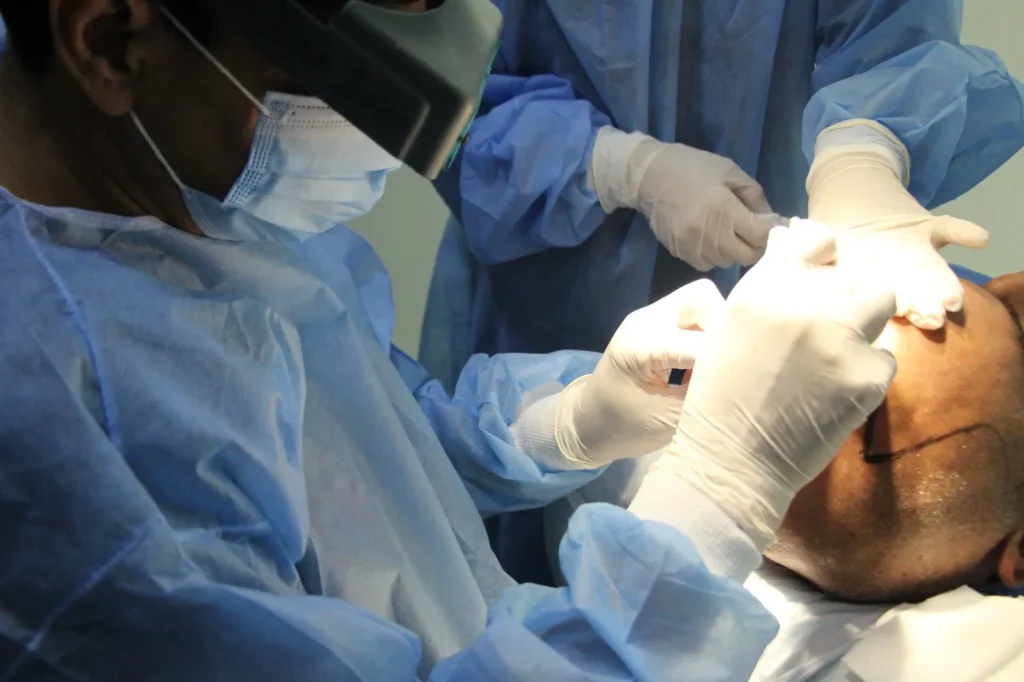Wondering Where Do Hair Transplants Come From and how the process actually works? Hair transplants involve relocating hair follicles—typically from the back of the head—to thinning or balding areas. Understanding where this donor hair is sourced from can help you make informed decisions.
In this guide, you’ll learn about donor areas, modern extraction methods, expert insights, and more, ensuring you know exactly how and why your transplant works.
What Is a Hair Transplant?

Definition and Overview
A hair transplant is a surgical procedure that restores hair to thinning or bald areas by relocating healthy hair follicles. These follicles are taken from areas with dense, permanent hair growth, called donor sites, and implanted in areas lacking hair.
Purpose and Who It’s For
Hair transplants are most commonly used to treat:
- Male pattern baldness (androgenetic alopecia)
- Female hair thinning
- Hair loss due to trauma or scarring
Candidates typically have healthy donor hair and realistic expectations about outcomes.
Where Does Donor Hair Come From?
Scalp Donor Zones – The Gold Standard
The most common source of donor hair is the occipital scalp, located at the back and sides of the head. This region is genetically resistant to DHT (dihydrotestosterone), the hormone responsible for pattern baldness.
Why it’s preferred:
- Resistant to future hair loss
- Thick and consistent in texture
- Blends well with frontal scalp hair
Can Body Hair Be Used?
Yes, in some cases where scalp donor hair is limited, body hair may be harvested.
Sources include:
- Beard (most preferred among body hair)
- Chest
- Arms or legs (rarely)
However, body hair differs in growth cycle and texture, so it’s typically used as a supplementary option.
FUT vs. FUE: How Hair Is Extracted
Follicular Unit Transplantation (FUT)
- FUT involves removing a strip of scalp from the donor area.
- Hair follicles are then dissected and implanted.
- Leaves a linear scar but offers a high graft yield.
Follicular Unit Extraction (FUE)
- In FUE, Individual follicles are extracted using micro punches.
- No linear scar; quicker healing.
- Preferred for minimal scarring and faster recovery.

Is All Donor Hair Created Equal?
Factors Influencing Donor Hair Quality
Not all hair is suitable for transplantation. Key factors include:
- Thickness: Thicker follicles provide better coverage.
- Texture: Similarity to the recipient area ensures natural blending.
- Growth cycle: Hair should be in the active growth phase (anagen).
How Surgeons Choose the Ideal Donor Site
A good hair transplant surgeon evaluates:
- Hair density using trichoscopy
- Scalp laxity and flexibility
- Risk of overharvesting
Pro Tip: Always ask your surgeon how they plan to preserve donor area integrity for future needs.
How Hair Transplant Techniques Have Evolved
Historical Origins: From Japan to Modern Times
The concept of hair transplantation began in the 1930s in Japan. It evolved significantly in the 1950s with punch grafting, eventually progressing into modern FUT and FUE techniques.
Technological Advances in Hair Extraction
- Robotic FUE: Uses AI-assisted tools for precise follicle extraction.
- DHI (Direct Hair Implantation): Allows simultaneous extraction and implantation, reducing follicle handling time.
The Role of Expertise in Donor Hair Management
Why Surgeon Skill Matters
Donor management is as important as implantation. An expert surgeon:
- Prevents overharvesting
- Maintains donor site aesthetics
- Ensures long-term availability
What Happens If the Donor Area Is Poor?
Options include:
- Using beard or body hair
- Artificial hair implants (limited and may have side effects)
- Scalp Micropigmentation (SMP) for visual density

FAQs About Donor Hair in Transplants
Can you use someone else’s hair for a transplant?
No. Hair from another person will be rejected by your immune system. Only your own hair can be used to prevent complications.
What happens if the donor area runs out?
Alternatives include body hair or cosmetic treatments like SMP. A good surgeon avoids overharvesting to preserve options.
Is body hair as effective as scalp hair?
Body hair can work but generally has a different texture and growth cycle. Beard hair is the most viable among body sources.
Do hair transplants last forever?
Transplanted hair from the permanent zone typically lasts a lifetime, although native hair may continue to thin over time.
Can donor areas regrow hair after extraction?
No. Extracted follicles do not regrow. That’s why donor area planning and spacing are crucial.
Expert Advice from Dr. Rana Irfan (ABHRS/ISHRS)
How to Maintain a Healthy Donor Area
- Avoid trauma or overexposure to the sun
- Use gentle hair care products
- Follow post-op care strictly for healing
Tips for Choosing the Right Surgeon
- Look for ABHRS or ISHRS certifications
- Ask about the donor management strategy
- Review before/after cases and testimonials
The Origin Story of Your Transplant
Your hair transplant’s success hinges on understanding where the hair comes from, how it’s selected, and who performs the procedure. The donor area—whether from your scalp or body—must be chosen with precision and care to ensure lasting, natural results.
When guided by a skilled and certified surgeon like Dr. Rana Irfan, you’re not just restoring hair—you’re investing in a long-term transformation with minimal risks.
